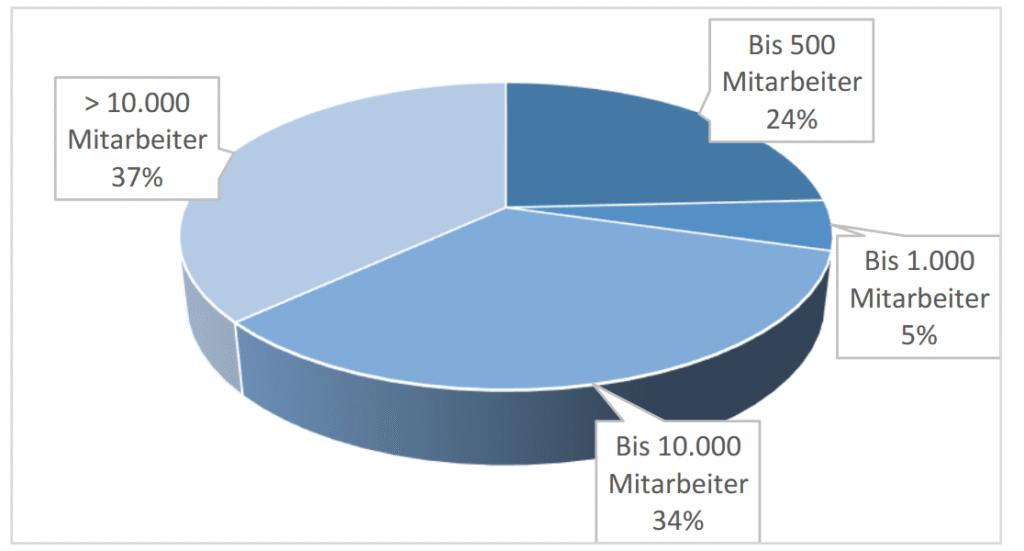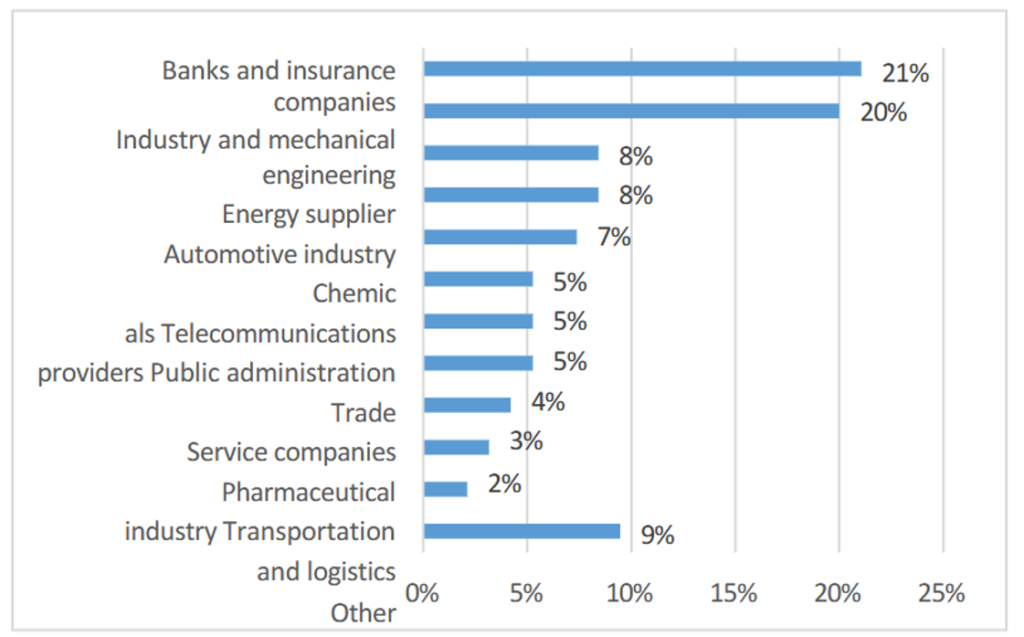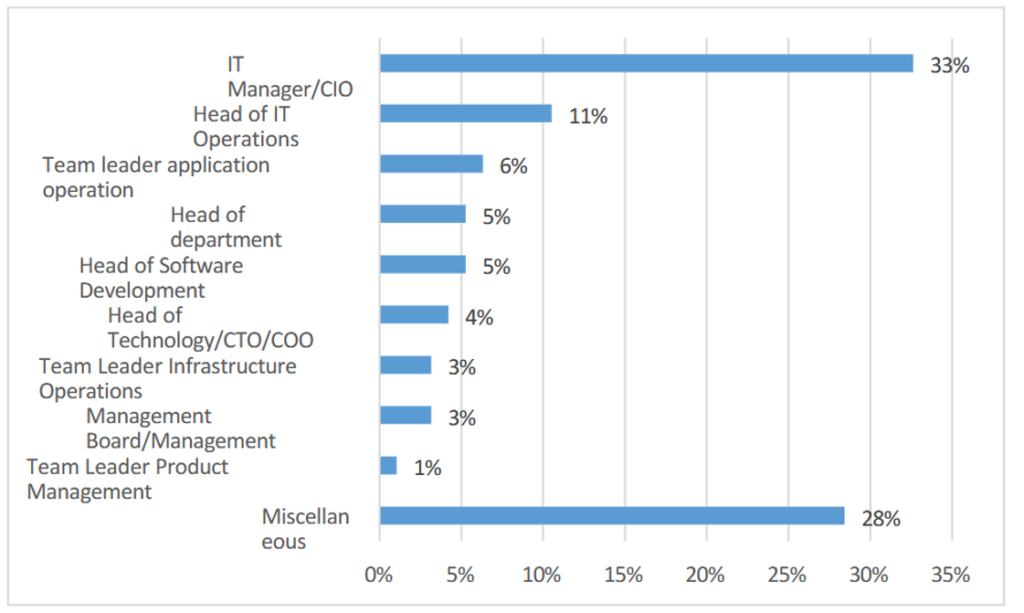
Better decisions through improved communication and collaboration between IT and specialist departments (business) - BizOps
Copyright and disclaimer: This study was conducted by GROHMANN BUSINESS CONSULTING on behalf of amasol AG. The data and information it contains were compiled with the utmost care.
However, no liability can accepted for their completeness and accuracy.
All rights to the content of the study are held by amasol GmbH.
Reproductions and publications: The use of this , including excerpts, is only permitted with the written consent of amasol GmbH.
Disclaimer: The reproduction of common names, trade names, product designations, etc. in this work, even without special identification, does not justify the assumption that such names are to be regarded as free within the meaning trademark and brand protection legislation and may therefore be used by anyone. Reference in this work to any specific commercial product, process or service by trade name, trademark, manufacturer’s designation, etc. does not imply endorsement or favoring by any means.
Foreword
What should modern business processes look like in an increasingly digital world? Ideally, they should be deeply networked with a company’s agile IT processes. Controlled, optimized and operated by interface teams from “Business” and “Operations”. In short: BizOps.
BizOps is a new method that brings together teams, technologies and end-to-end processes to achieve important business goals. Similar to the service-oriented transformation that DevOps has brought to IT and technology, BizOps brings about a fundamental shift towards innovation, agility and more automated processes in IT, sales, marketing and controlling.
The aim of the BizOps trend study was to,
– to query the current status of knowledge of the term BizOps,
– to find out which topics are associated with the term BizOps,
– to inquire about the plans for BizOps,
– Clarify responsibilities for the topic of BizOps within the company,
– to determine which arguments/drivers speak in favor of using BizOps,
– to clarify what obstacles/hurdles exist for the use of BizOps in the company.
We would like to take this opportunity to thank the participants once again for their support and wish everyone else an interesting read with important insights and suggestions for their own daily work.
Munich, March 2021
amasol GmbH
(www.amasol.de)
BizOps Trend Study 2021 – Summary
Below you will find an overview of the most important results of the BizOps Trend Study 2021:
– Almost 90 percent (88%) of survey participants rate the complexity of their IT as high or very high.
– 63% of the companies surveyed are already in the midst of digital transformation, while a further quarter (25%) have already launched their first digitalization projects.
– Poor coordination between the departments/teams involved was most frequently cited as the biggest hurdle/obstacle to digital transformation (58%), followed by isolated data silos (45%) and inefficient use of time/resources (35%).
– For most respondents (44%), the management/board of directors should initiate improved cooperation between IT and the company.
– 29 percent of survey participants have already introduced BizOps in their company (or are in the process of doing so), while a further 36 percent rate BizOps as an interesting method or believe that it could be a next step.
– 58 percent of respondents cite a lack of knowledge as the main reason why there is currently no BizOps planning in the company.
– 60 percent of participants state that a committee from IT and business is or should be responsible for the introduction of BizOps.
– For 61 percent of respondents, the main advantage of BizOps is more successful digitalization initiatives that are geared towards business success and customer satisfaction.
Results
At the beginning of the survey, respondents were asked about the size and sector of the company for which they work. They were also asked about their position in the company.
Information about the participants
Size of the company

Company branch

Named under “Other” were: Health insurance, culture, health, IT, trade fairs and events, automotive+ industry/mechanical engineering, textiles, e-commerce, n.a..
Position in the company

The following were named under “Other”: Architect for Cloud Solutions, Cloud Architect, Program Manager, CDO, CISO, EAM, Head of Technical IT Application Management, Manager IT Strategy, IT Application Manager, Project Management, IT Architect, PMO, IT Business Partner, VP IT for Operations and R&D, Project Manager, Project Manager IT, Teamlead Demand Management, Teamlead PMO, Administrator, PMO, Teamlead div. Software product sales, CIO consultant, application supervisor, head of digital transformation, project manager, head of IT for PLM production, purchasing and logistics, n.a.
IT in the company – current challenges
In the first content section of the BizOps Trend Study 2021, participants were asked to provide an overview or assessment of the current challenges facing IT in their company.
The first question related to the current complexity of IT in their own company.
How do you rate the current complexity of your company’s IT? (n=95)
Almost 90 percent of respondents (88%) rate the current complexity of their IT as high (44%) or rather high (44%).
The survey participants were then asked to evaluate a number of predefined statements on the current status of their IT environment.
The first statement concerned a forecast of IT complexity within the company.
The complexity of the IT environment in our company will probably increase significantly in the next 18 months. (n=95)
63 percent of respondents (tend to) assume that the complexity of IT in their company will increase significantly over the next 18 months, while one fifth of respondents do not share this opinion.
The next statement concerned the impact of new IT technologies and methods on IT complexity.
New IT technologies and methods (e.g. DevOps, agile methods, micro services, container-based applications) have further increased IT complexity. (n=95)
58 percent of respondents (tended to) agree with the statement that new IT technologies and methods are drivers of increasing complexity.
The survey participants were then asked to rate the extent to which the KPIs used by the IT department match the metrics used by the specialist departments.
The metrics (KPIs) by which IT evaluates its success (IT performance, application availability, project completion, etc.) do not help to the metrics of the specialist departments (higher turnover per customer, higher number of sales per hour, etc.) (n=95)
Almost 60 percent (58%) of the companies surveyed admit that the metrics used by IT do not contribute to improving the business success of the specialist departments. It is precisely at this point that there is decisive potential for optimization, because only if IT evaluates its success on the basis of metrics that are also assessed as success factors by the business can the sustainable success of joint initiatives be guaranteed.
Finally, the participants were asked to evaluate the statement that the complexity of IT in their own even creates “chaotic conditions” for companies.
The complexity of IT has led to a kind of chaos in the company. (n=95)
Only a quarter (25%) of respondents (tend to) agree with the statement that IT completeness has led to a kind of chaos in the company. Three quarters of respondents (tend to) disagree with this statement.
The next question dealt with the current status of digitization efforts in the companies surveyed.
How do you rate the current status of digital transformation measures in your company? (n=95)
The result reflects the great importance that digital transformation/digitalization has for companies in particular. Only one percent of survey participants stated that digital transformation does not (yet) play a role for their company.
In contrast, the majority of the companies surveyed (63%) are currently in the middle of their digital transformation. A further quarter (25%) stated that at least initial digital transformation measures or projects had already been launched. Only five percent that they have already (largely) completed the digital transformation in their company.
What are the biggest hurdles/obstacles to digital transformation? (n=95)
“Poor coordination between the departments/teams involved” was most frequently cited as a hurdle or obstacle to digital transformation (58%), followed by “isolated data silos” (45 %) and “inefficient use of time/resources” (35 %).
Among other things, the following was mentioned under “Other”:
– The attempt to transform processes instead of rethinking them
– Inappropriate corporate culture
– Silo mentality in the divisions, adherence to traditional methods
– Dependence on central service provider
– Regulation/regulatory requirements
– Budget
– Unclear technical requirements, little knowledge of the technology’s potential, no clear definition of the problem to be solved. Use of technology as an end in itself
– Employees’ fear of losing their jobs
– Change management
– No clear definition of “digital transformation” in the corporate context
– The “big picture” of both IT and the affected area is almost always missing (e.g. where does Sales want to be in 6, 12, 24, 36 months and what role do digital components play in this?
– Resource bottlenecks (employees)
– Unclear goals
– Mindset, discouragement & inconsistency
– Little understanding at management level
– Unclear project portfolio strategies
– Too little capacity
– Different application owners
IT in the company – cooperation between IT and business
Part 3 of the BizOps Trend Study 2021 focused on collaboration between IT and business (specialist departments).
As an introduction to the topic, the survey participants were asked to assess the current collaboration between IT and business in their company.
How do you rate the current collaboration between IT and business in your company? (n=95)
61% of survey participants rate the collaboration between IT and business as positive. However, more than a third still room for improvement in the collaboration.
The next question was about finding out where respondents believe the greatest obstacle to cooperation between business and IT lies.
Where do you see the biggest obstacle to collaboration between IT and business? (n=95)
The biggest obstacle cited was that business and IT pursue different goals (28%). This once again underlines the result regarding IT success indicators, which, according to a majority, do not contribute to the success of the specialist departments. IT and business apparently still find it difficult to understand that only jointly defined and pursued goals ultimately ensure the overall success of the company.
In second place is the lack of understanding/knowledge of each other’s topics (25%). Among other things, the following was mentioned under “Other”:
– Often lacking innovative strength
– Budgets
– Organization: the structure of the IT department is not oriented towards the customer (business), so the individual units are not evaluated according to what they have achieved for their customer group or for the organization as a whole
– Unclear overarching structural guidelines
– Lack of common value chain orientation
Finally, the survey participants were asked who they thought should initiate improved collaboration – where necessary – between IT and business.
Who should initiate improved collaboration between IT and business? (n=95)
44% of respondents are of the opinion that management/the Board of Directors should initiate improved cooperation between IT and business. A committee consisting of IT and business was mentioned second most frequently (37%).
BizOps – current status, advantages and obstacles
The fourth part of the BizOps Trend Study 2021 was concerned with finding out the current status of the use of the BizOps approach in the companies surveyed, as well as the benefits and obstacles associated with the use of BizOps.
In the first question, survey participants were asked to provide an assessment of the current BizOps status in the company.
How do you rate the current BizOps status in your company? (n=95)
29 percent of the companies surveyed have already introduced BizOps in their company or are in the process of doing so. A further 36 percent consider BizOps to be an interesting method and/or assume that BizOps could be a next step. BizOps currently plays no role for 22 percent of survey participants. For five percent, even agile working methods play no role. Under “Other” was indicated among other things:
– Agile working methods play an important and increasingly important role for us
– We have been developing an area for this interface for 1.5 years
– In terms of content, we are already partly with BizOps
– The aim is to improve collaboration via IT demand and project management, whether this can be called BizOps… difficult
– They probably already do a lot of things, they just haven’t called them BizOps yet
In the next question, companies that are not currently involved in BizOps should provide information about their future BizOps plans.
What your company’s future plans in the area of BizOps? (n=67)
Almost half of the survey participants (49%) who do not currently use BizOps are also unable to give an assessment of their future plans. 36% are not currently planning to introduce BizOps methods. The remaining 15 percent have planned to introduce BizOps methods.
Participants who were planning to introduce BizOps were then asked when they planned to introduce it.
In what timeframe do you the introduction of BizOps methods to be realistic? (n=10)
The majority of companies that would like to introduce BizOps methods in the future plan to do so within the next six to twelve months (30 %) or within the next twelve to 24 months (60 %).
In contrast, those survey participants who were not planning to introduce BizOps methods were asked why they were not doing so. Only one main reason could be given in each case.
If there are no plans for BizOps, what reasons do you think could be responsible for this? (n=24)
Too little knowledge about the BizOps methodology is the most frequently cited reason why companies are not yet planning to use it (58%). A lack of awareness at decision-maker level is the main reason for 29% of survey participants. Complexity and effort are the main reason for only eight percent of respondents for not yet considering the use of BizOps.
The next question dealt with the responsibility for the introduction and implementation of BizOps methods in the company.
Who is/should be responsible for the introduction and implementation of BizOps methods in your company? (n=95)
For a clear majority of respondents, a committee from IT and business should or is responsible for the introduction and implementation of BizOps methods (60%). Respondents were then asked what advantages they associate with BizOps.
What advantages do you associate with BizOps? (n=95)
The most frequently cited advantage of BizOps was that it leads to more successful digitalization initiatives that are geared towards business success and customer satisfaction (61%).
In second place is the advantage that IT is evolving from a “cost center” to a “value center” (58 %).
This was closely followed by the advantage of “faster response to customers and market requirements” (57%).
Under “Other” was mentioned, among other things:
– Bringing innovative strength into the company
– IT must align its own organization with the customer/can no longer hide
– Improving cooperation between specialist departments and IT
At the end of Part 4 of the BizOps Trend Study 2021, survey participants were asked to indicate who they thought would benefit most from the introduction of BizOps and who would lose the most if BizOps were not introduced.
BizOps – A look into the future
The final part of the BizOps Trend Study 2021 looked to the future. As an introduction, the survey participants were asked rank the areas of action that they would prioritize for the implementation or expansion of BizOps.
Which fields of action for the realization or expansion of BizOps do you give top priority to? (n=95)
Improving communication in cross-functional teams is most frequently cited as the BizOps action area with the highest priority (47%), followed by eliminating the “chaos in IT” caused by cloud architectures through the use of artificial intelligence.
At the end of the BizOps Trend Study 2021, the survey participants were asked to what extent they could imagine actively supporting or further developing the relatively new BizOps methodology.
BizOps is a relatively new methodology. Can you imagine actively supporting and further developing this approach? (n=95)
Almost half (48%) of the survey participants expressed a fundamental interest in the BizOps methodology, while a further 40% would even like to be actively involved in the further development of the topic. Only eight percent are not interested.
One of the reasons given under “Other” was that internal changes in the company (e.g. restructuring) do not currently permit any involvement.
Interview on the results of the BizOps Trend Study 2021
The digital transformation is in full swing: companies are saying goodbye to processes and are successful with digital business models. If the IT behind it works!
amasol supports companies in correctly measuring, optimizing and agilizing the performance of their IT services.
In the following interview, Frank Jahn, CEO and CSO of amasol GmbH, comments on the results of the BizOps Trend Study 2021.
Question: Can you briefly explain what goals you were pursuing with the BizOps Trend Study 2021?
Jahn: We at amasol have been following the topic of BizOps for some time. We ourselves are convinced by the approach and therefore wanted to know how the associated topics are viewed, particularly in German companies. All studies Ive seen so far have been international in scope and paid far too little attention to German-speaking countries.
Question: Almost 90 percent of survey participants rate the complexity of their IT as high or very high. In your project experience, what are the reasons for this high level of complexity in IT?
Jahn: The reasons for the rapidly growing complexity of modern IT environments – as confirmed by our project experience – certainly lie in the multitude of new technologies that have to be integrated into the existing infrastructure, above all new operating models such as public cloud, hybrid cloud or even multi-cloud. This is associated with the need to implement and realize new processes and methods for the management of these heterogeneous infrastructures. It is more than understandable that this is perceived by those involved as continuously increasing complexity.
Question: Poor coordination between the departments/teams involved was most frequently cited as the biggest hurdle/obstacle to digital transformation, followed by isolated data silos and inefficient use of time/resources. How do you rate this result?
Jahn: Unfortunately, this is no surprise. But this is exactly where the BizOps framework comes in as a solution. BizOps gives direction to communication between IT and specialist departments. The specialists then have to “climb out” of their silos in order to get answers to BizOps questions from their colleagues. That’s already a start. And one more word on the subject of inefficiency: inefficiencies always arise where development may be fast (DevOps) but bypasses the customer.
Question: Almost two thirds of respondents are already actively involved with BizOps or believe that it could be a next step. What advice do you have for companies that want to get involved with BizOps?
Jahn: As a rule, there are already some existing approaches that companies can build on. The only question that then arises is: should BizOps be implemented on a small scale, e.g. in relation to a service, or company-wide? In this case, I am a friend of small steps. A good starting point is a new digital service that is based on the latest technologies and is characterized by good observability (collection of metrics, logs and traces). The operational data provides a basis for discussion in order to coordinate the same goals with the business. However, there are also examples of the “big hit”. For example, the former BMW CIO Klaus Straub introduced agile methods throughout his IT department. I think that some industries in particular are currently under a lot of pressure and need to reinvent themselves quickly. BizOps can play a major role here as a company-wide concept.
Question: For 61 percent of survey participants, the main advantage of BizOps is more successful digitalization initiatives that are geared towards business success and customer satisfaction. Are the survey participants correct in their assessment? What other benefits result from the use of BizOps?
Jahn: The fact that two thirds see the main benefit of BizOps in business success and customer satisfaction follows the logic of the BizOps concept. The fact that only three percent of respondents see the benefits of BizOps on the IT side is certainly due to the fact that the majority of respondents come from IT. However, I think that IT also benefits from the realization of greater business success and customer satisfaction, in terms of its position within the company.
Question: Finally, a personal conclusion on the results of the BizOps Trend Study 2021: Was there one result that particularly surprised you?
Jahn: Yes, there was that. When asked about the chaos caused by greater complexity in IT, I sensed a certain indignation between the lines of the answers. 46 percent answered that they do not any chaos caused by increasing complexity. This formulation and assumption is mentioned in one breath in the American trade press and is practically presented as the truth. Obviously, IT organizations in our region are coping much better with complexity. I really hadn’t expected this reaction.
Thank you very much for the interview
Discover more about amasol

Our expertise
Benefit from over 25 years of deep expertise and high-quality service delivery across our key areas

Resource center
Search through our library of resources for inspiration on how amasol has helped other customers to power their experience business.

Our tools
Explore the tools and partnerships that help us drive success and optimize your IT environment.

Why amasol
We aim to increase agility, increase the value proposition and improve the efficiency of IT and thus increase business success.
amasol
Additional Resources
Legal Information

MUNICH
Campus Neue Balan
Claudius-Keller-Straße 3B,
81669 Munich, Germany

VIENNA
Gertrude-Fröhlich-Sandner-Str. 2-4, Tower 9,
1100 Vienna, Austria

NEW DELHI
13/24 2ND FLOOR
West Patel Nagar New Delhi
110008 India

LONDON
60 St Martins Lane Covent Garden,
London, WC2N 4JS, United Kingdom
